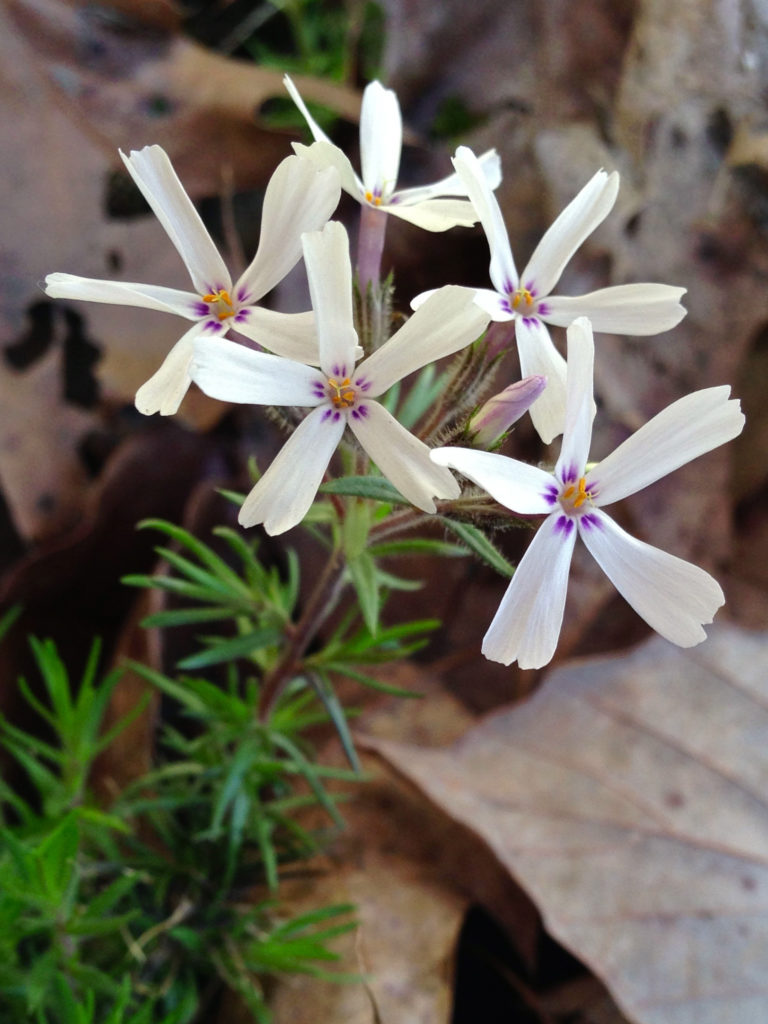Phlox subulata, often called Moss Pink even though it comes in as many colors as the other groundcover Phloxes, is a mat-forming, sun-loving, semi-evergreen herbaceous perennial found in rocky and sandy barrens from New York to Michigan and south to Georgia and Louisiana. Leaves are needle-like or linear, and the vegetative mat is only about 6 inches tall. The flowers are five-lobed as is typical of Phloxes, with notched outer margins and fused at the base into a narrow tube containing the floral parts, including the golden yellow exserted stamens. It withstands hot, dry locations better than some of the other Phloxes, and contributes hugely to the landscape with a sweep of fabulous color (your choice!) for 3-4 weeks in spring and vigorous ground-covering thereafter. Phlox subulata tolerates thin, poor soils, and is even recommended for remediation of difficult, disturbed sites.
NURSERY HOURS
Wednesday: 10-4 Thursday: 10-6 Friday-Saturday: 10-4 Sunday: 12-4
Phlox subulata ssp. subulata

Key Info
Scientific Name: Phlox subulata L. ssp. subulata
Common Names: Moss Pink, Moss Phlox, Mountain Phlox, Creeping Phlox, Rock Pink
Family Names: Polemoniaceae (Jacob's Ladder Family)
Plant Type: Herbaceous perennial
Leaf Retention: Semi-evergreen
Flower Color: Purple, lavender, rosy pink, pink, white, or bicolored.
Additional Info
Habit: A semi-evergreen, mat-forming perennial with linear leaves and a shallow, fibrous root system. The spreading stems may become woody with age. This plant spreads by reseeding itself, not by rooting in at the nodes of prostrate stems like some other Phloxes.
Height: ¼' to 3⁄4' (3" to 9")
Spread: 1' - 2'
Soil Conditions: Medium to dry, well drained, circumneutral to slightly alkaline pH (but tolerant of slightly acid pH); plants tolerate sandy or rocky, disturbed, poor, infertile soil, clay.
Leaves: Leaves are linear and opposite and, unusually, with clusters of smaller leaves developing from the axils of the opposite leaves, causing them to appear whorled. Leaves are ¼ to 3⁄4 inches long, sessile, with entire margins.
Flowers (or reproductive structures: The corollas of the flowers are ½–¾" across and almost as long; they have narrowly tubular bases and 5 spreading lobes typical of Phloxes. The lobes are oblanceolate in shape and moderately notched. Within the narrow throat of each corolla, there are 5 stamens and a pistil with a single style, the stamens exserted. Solitary or small cymes of 2-8 flowers occur at the tips of stems on short pedicels (not on separate, flowering stems).
Fruit: Flowers develop into small, 3-valved seed capsules containing 3 or more seeds.
Natural Distribution: Rocky and sandy barrens, savannas, rocky ledges, slopes, clearings and disturbed sites in eastern United States.
USDA Hardiness Zone: 3 - 9
USDA Wetland Indicator Status in NC: not available
Pollination: Long-tongued insects; Swallowtail butterflies, day flying Sphinx moths, Hummingbird moths and Clearwing moths; and Hummingbirds.
Wildlife Connections: Attracts many pollinators.
Propagation: Propagate by division of root ball in spring immediately after flowering every few years to obtain more plants and to keep the old plants healthy; or by transplanting of rooted stems; or by stem cuttings in spring.
